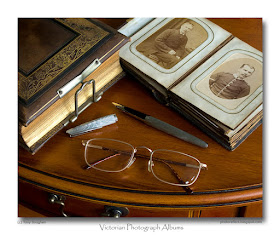 click photo to enlarge
click photo to enlargeThe other day I was looking at a couple of Victorian albums that contain photographs of some of my wife's ancestors. As I turned the pages, looking at the sepia and hand-coloured images of men and women posing in photographers' studios, I reflected that a print is still the best way of archiving family snaps. The dress of the people in these photographs - men in suits or military uniform, women in their finery, and children dressed like miniature adults - are of a style that suggests most of the shots are from the second half of the nineteenth century, with some from the early 1900s. And yet these photographs, of which many are well over 100 years old, still look clear, sharp, and for the most part show little evidence of fading.
When I shot 35mm film my final images were either black and white, colour prints, or colour transparencies. I converted to digital photography in 2000. During that first year I made an album, printing photographs of different sizes on a single sheet of paper, and captioning them. I'm ashamed to say that since that time my printed output has declined substantially. Like many photographers my archives remain digital. I keep RAW files ordered by date and location, and processed files by date and caption. I do print images but these are usually larger format for display - from 10x8 inches up to 13x19 inches, and very occasionally a few 6x4 inches snapshots. There are those who argue that digital archives are the easiest and best way of storing photographs, and for keen amateurs and professionals that is certainly so. But for the average person (and the keen amateur and professional), who might well want the images to pass down through future generations as a piece of family history, I can see them being next to useless. No, for that purpose you can't beat durable prints, because they require no special (or maybe obsolete) equipment to view them, and are so easy to access.
However, there is one additional item that is guaranteed to make them last longer, and be valued more highly by your descendants, and that is an expensive, attractive and durable album. Had the prints in today's photograph been stored in shoe boxes I very much doubt whether they would have survived beyond a few decades. But, in leather-bound albums with metal clasps, mounted in frames on gold-leaf edged pages, they became objects of fascination and beauty, repositories of the family's past, and heirlooms to be cherished. The albums shown above have all those qualities and more, and yet they lack one vital finishing touch: they aren't captioned. This is a small tragedy. Some have a few notes about the people shown, written in pencil on the back. But the rest are anonymous except for those that an aged relative was able to identify before she died.
So, my recommendation to photographers is "look to the future now". The images we make that are most significant to our families are those of relatives and friends. Print those shots, bind them well, caption them carefully, and you'll earn the gratitude of generations not yet born. There's only one problem with me dispensing exhortations of this sort: I'll now have to make a start on following my own advice!
photograph & text (c) T. Boughen
Camera: Olympus E510
Mode: Aperture Priority
Focal Length: 35mm macro, (70mm/35mm equiv.)
F No: f8
Shutter Speed: 1/5
ISO: 100
Exposure Compensation: -1.0 EV
Image Stabilisation: On